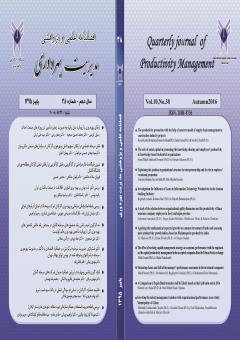ارتقای بهره وری با رویکرد مدل یکپارچه مدیریت زنجیره تأمین در پروژه های صنعت احداث
محورهای موضوعی : مدیریت بازرگانیرسول کریمی 1 , محمد حسین صبحیه 2 * , جعفر رزمی 3 , سید علی ترابی 4
1 - دانشجوی دکتری، دانشگاه تربیت مدرس، تهران، ایران
2 - استادیار دانشگاه تربیت مدرس، گروه مدیریت پروژه و ساخت، تهران، ایران
3 - استاد دانشگاه تهران، گروه مهندسی صنایع، تهران، ایران
4 - دانشیار دانشگاه تهران، گروه مهندسی صنایع، تهران
کلید واژه: مدل مفهومی, مدیریت زنجیره تأمین پروژه, صنعت احداث,
چکیده مقاله :
بررسی ها نشان می دهد زنجیره تأمین پروژه در مقایسه با زنجیره تأمین عملیات تفاوت های اساسی دارد و مدیریت آن نیازمند رویکردهای متفاوتی است. با توجه به اهمیت مدیریت زنجیره تأمین پروژه، مدل هایی در این زمینه در کشورهای توسعه یافته ارائه شده است اما نظر به تفاوت مبانی توسعۀ مدل ها بین کشورهای توسعه یافته و کشورهای در حال توسعه، ویژگی های مدیریت زنجیره تأمین در این کشورها تفاوت های بسیاری دارند. این مقاله به توسعه مدل مفهومی مدیریت زنجیره تأمین در پروژه های صنعت احداث کشور جهت تطبیق ساختار مدیریت زنجیره تأمین پروژه با چالش های موجود در زنجیره تأمین پروژه ها می پردازد. در این مدل با استفاده از تئوری ساخت یافته داده بنیاد، شرایط علی یا ظهور چالش ها، عناصر بستر ساز، عناصر اقتضایی و ارتباط بین آنها در زنجیره تأمین پروژه های صنعت احداث ایران شناسایی شده و راه کارهای مدیریت چالش ها و نتایج مورد انتظار از اجرای آنها در راستای موفقیت زنجیره و موفقیت پروژه در قالب مدل مفهومی مدیریت یکپارچه زنجیره تأمین پروژه ارائه شده است.
Studies have indicated that there are fund mental differences between the project supply chain and operation supply chain and its management calls for different approaches. Considering the importance of project supply chain management, different models have been offered by developed countries, but according to the difference development models between the developed, developing countries, the characteristics of the supply chain management of these countries are very different. This study aimed at developing a conceptual model of project based construction industry in Iran to compare the structure of project supply chain management with existing challenges in project supply chain. Using construction theory the casual conditions of emerging of challenges infrastructure elements were indentified and the procedures of challenging management and its expected results were presented.
- Asbjørnslett, Bjørn Egil(2002), Project Supply Chain Management From Agile to Lean, Norwegian University of Science and Technology; for the degree of doctor of Philosophy; November
- Atkinson, R. (1999), Project Management: Cost, time and quality, two best guesses and phenomenon, it’s time to accept other success criteria, International Journal of Project Management, 337-342
- Basu, R and Wright, J.N.(2008), Total Supply Chain Management, Elsevier, Oxford.
- Bazargan, A. (2008), Mixed Methods Research in Management Studies ;Tehran: Agah Publication (in Persian).
- Dainty, A.R.J., Briscoe, G.H. and Millett, S.J. (2001), “Subcontractor perspectives on supply chain alliances”, Construction Management and Economics, Vol. 19 No. 8, pp. 841-8.
- Emuze F.A., (2009), ‘’the impact of construction supply chain management on the vale projects’’. A master’s degree thesis submitted at school of Built environment, Nelson Mandela Metropolitan University, Port Elizabeth, South Africa
- Hobday M(2000), The project-based organisation: an ideal form for managing complex products and systems?, Research Policy Journal, 2 , 871–893.
- Hoxley, M. ((2000) "Measuring UK construction professional service quality: the what, how, when and who", International Journal of Quality & Reliability Management, Vol. 17 Iss: 4/5, pp.511 - 526Ibn
- Khalfan, M. M. A., Anumba, C. J., Siemieniuch, C. E. & Sinclair, M. A. (2001). Readiness assessment of the construction supply chain for concurrent engineering. European Journal of Purchasing and Supply Management, 7(2), 141-53
- Kloppenborg, T.J,(2008), Contemporary Project Management, Cengage Learning
- Li, G., Yi, L., Wang, S. and Yan, H. (2006), “Enhancing agility by timely sharing of supply information”, Supply Chain Management: An International Journal, Vol. 11 No. 5, pp. 425-35
- Lincoln, Y. &Guba E. (1985), Naturalistic Inquiry, Beverly Hills: Sage Publications.
- Love, P E D, Irani, Z, Cheng, E and Li, H (2002), A model for supporting inter-organizational relations in the supply chain, "Engineering, Construction and Architectural Management", 9 (1), 2-1.
- Sachan, A.&Datta, S.(2005), Review of supply chain management and logistics research. .International Journal of Physical Distribution & Logistics Management, 35(9/10), 664-705.
- Sarmad,Z. Bazargan, A. and Hejazi, E. (2002), Research Method in Humanities; Tehran: Agah Publication (in Persian).
- Shenhar, A.J., Levy, O. and Dvir, D.(1997). Mapping the dimensions of project success.Project Management Journal 5-13
- Strauss, AL.& Corbin, JM.(1998), Basics of qualitative research: techniques and procedures for developing grounded theory, California: Thousand Oaks.
- Thiry M, Deguire,M(2007), Recent developments in project-based organizations, International Journal of Project Management, 25, 649–658
- Tommelein, I.D., Ballard, G., and Kaminsky, P. (2009), "Supply Chain Management for Lean Project Delivery." Chapter 6 in O'Brien, W.J., Formoso, C.T., Vrijhoef, R., and London, K.A. (eds.) Construction Supply Chain Management Handbook. CRC Press, Taylor & Francis Group, Boca Raton, FL.
- Venkataraman, Ray R ,Pinto, Jeffrey K.(2008), Cost and Value Management in Projects, John Wiley & Sons, Hoboken, New Jersey
- Vrijhoef, R. and Koskela, L. (2000), “The four roles of supply chain management in construction”, Journal of Purchasing & Supply Management, Vol. 6, pp. 169-178.
- Wong, A. and Kanji, G.K.(1998), Quality culture in the construction industry. Total Quality Management,9(4,5),133-140.
- Wickramatillake, C., Koh, S., Gunasekaran, A. and Arunachalam, S. (2007), “Measuring performance within the supply chain of a large scale project”, Supply Chain Management: An International Journal, Vol. 12 No. 1, pp. 52-9.

